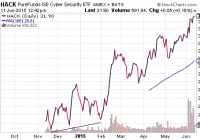Should Investors Take A HACK At This Idea?
The latest case of cyber espionage has resulted in the theft of personal information of more than 4 million government employees. The sophistication, scale and frequency of cyber-attacks has only increased, and threats are becoming more and more complicated. Let’s get a lay of the land of companies that are poised to help put down such criminal behavior, and how investors can play this secular theme. You may be surprised by our favorite idea in this space. “The new generation of cyber-attacks on organizations, including large and small enterprises and governments worldwide, is characterized by an unprecedented escalation in the complexity and scale of advanced malware created by criminal organizations and nation-states. These modern attacks are built on dynamic, stealthy and targeted malware that penetrates defenses in multiple stages and through multiple entry points of an IT network. These highly targeted, “single-use” cyber-attacks easily circumvent legacy security solutions that rely on pattern-matching detection technologies. Additionally, because legacy solutions reference outdated signatures of past threats, they also generate a high number of false-positive alerts.” – FireEye (NASDAQ: FEYE ) Annual Report, 2014 The statistics are striking. According to a 2011 survey of ~580 US IT experts by research center Ponemon Institute, an estimated 90% of organizations have at one time suffered a cybersecurity breach. Believe it or not, the Pentagon said in a 360+ page report that as of 2014, nearly every US weapons program that was tested showed ” significant vulnerabilities ” to cyberattacks. The news reminds us of the 1980s flick WarGames . It flat-out irks us that there’s a chance that hackers can access US weapons programs. Just this week, US officials announced that it believes China was behind a breach affecting the information of at least 4 million federal employees. This was allegedly the second intrusion by the country in the past few months, and the largest breach of federal employee data in some time. Russia has also been tied to cybercrimes against White House computers. It appears the US is fighting yet another war – not one with guns, and bullets but one against cyber adversaries. The plot of that 1980s teenage Matthew Broderick movie can’t happen in real life, can it? The world is simply not prepared for the latest round of criminal activity… in cyberspace. The sophistication, scale and frequency of cyberattacks, coupled with the complexity of new technologies from cloud computing and virtualization to enterprise mobility and social networking have made it incredibly difficult to keep important information and data safe. Reports from the Snowden documents, for example, contend that China stole “many terabytes” of data about Lockheed Martin’s (NYSE: LMT ) F-35. China’s new J-31 Gyrfalcon does look a lot like the F-35. In 2014 alone, there were 20 major data breaches , with Home Depot (NYSE: HD ), Target (NYSE: TGT ), and JPMorgan (NYSE: JPM ) perhaps making the biggest headlines, but even companies such as Staples (NASDAQ: SPLS ), Bebe (NASDAQ: BEBE ), and Sony (NYSE: SNE ) were impacted. Sony’s network was taken hostage by a grinning skull . Some estimates peg the cyber security market to surpass $150 billion by 2019 from under $100 billion today, but the reality is that the changing and evolving landscape could make this figure much larger. Traditional players such as Hewlett-Packard (NYSE: HPQ ), Cisco (NASDAQ: CSCO ), Check Point Software Technologies (NASDAQ: CHKP ), Computer Sciences Corp. (NYSE: CSC ), IBM Corp. (NYSE: IBM ), Booz Allen (NYSE: BAH ), Lockheed Martin, Northrop Grumman (NYSE: NOC ), Trend Micro ( OTCPK:TMICY ), Fortinet (NASDAQ: FTNT ), Barracuda Networks (NYSE: CUDA ), and Symantec Corp. (NASDAQ: SYMC ) will be vying for share. But there are others as well. FireEye, Palo Alto Networks (NYSE: PANW ), Imperva (NYSE: IMPV ), VASCO Data Security (NASDAQ: VDSI ), Zix Corp. (NASDAQ: ZIXI ), Qualys (NASDAQ: QLYS ), Proofpoint (NASDAQ: PFPT ), AVG Tech (NYSE: AVG ), and CyberArk Software (NASDAQ: CYBR ) will be looking to capture a piece of the pie (potential industry earnings). Many of these firms are losing money hand over fist at the moment. From an investment standpoint, it’s simply too early to pick the long-term winners. But even if we we’re pinned down to selecting just one or two potential winners, we’d maintain that the best consideration for investment exposure to rapidly expanding cybersecurity demand is via the PureFunds ISE Cyber Security ETF (NYSEARCA: HACK ), which seeks to track the investment results of the ISE Cyber Security Index (the ETF’s holdings can be downloaded here ). Our investment thesis on HACK rests not on identifying which company will capture the greatest share of industry earnings, but on the view that spending on cybersecurity will increase considerably more than current expectations – a far “safer” bet. Disclosure: I/we have no positions in any stocks mentioned, and no plans to initiate any positions within the next 72 hours. (More…) I wrote this article myself, and it expresses my own opinions. I am not receiving compensation for it (other than from Seeking Alpha). I have no business relationship with any company whose stock is mentioned in this article.
